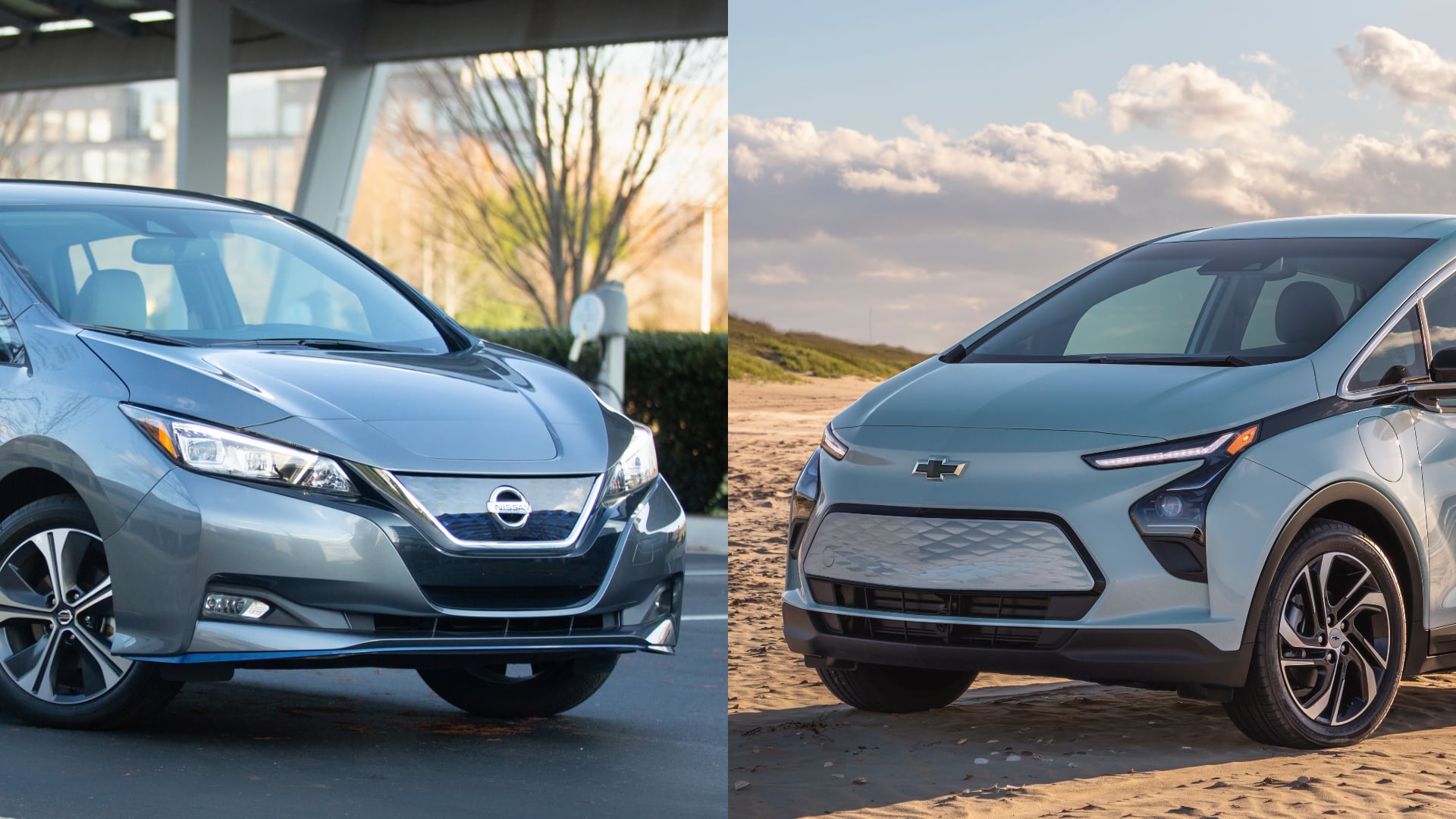Electric cars have been thrust from the fringes of our automotive world right into the mainstream thanks to the growing global trend of planning bans on the sale of new gasoline and diesel cars starting in 2030.
Manufacturers from North America, Europe, and Asia are working furiously to develop the EV “for the masses”-the electric car that eventually everyone will turn to as the emblematic model of the sector.
Two competing models for such a title are the Nissan Leaf and the Chevrolet Bolt. Let’s see what the Japanese giant and the homegrown US electric car have to offer.
Quick Summary
The popular Nissan Leaf is the more affordable electric vehicle, but it needs a bit of an overhaul to remain competitive. The redesigned Chevy Bolt offers better standard range, is more exciting behind the wheel, and offers superior technology features.
Pricing
Pricing can get a bit tricky when you’re talking about EVs in the US right now because there are still federal tax incentives in place that can reduce the actual amount you pay, but how much you get depends on other factors.
In terms of what’s shown on the Nissan and Chevy websites, the Nissan Leaf is the cheaper at the base-level, starting at $27,400, but Nissan makes it clear that this price is a suggested MSRP, and doesn’t include things like tax and destination charge. There are 5 trim levels, the S, SV, S Plus, SV Plus, and SL Plus. The top-level SL Plus starts at $37,400.
The Chevy Bolt base-level 1LT trim starts at $32,495 and includes destination charge. It doesn’t, however, include tax, title, license, dealer fees and optional equipment. The 2LT trim comes with some significant upgrades and starts at $35,695.
Overall, it’s obvious these two electric cars are very much direct competitors targeting the same segment, given how closely their pricing is.
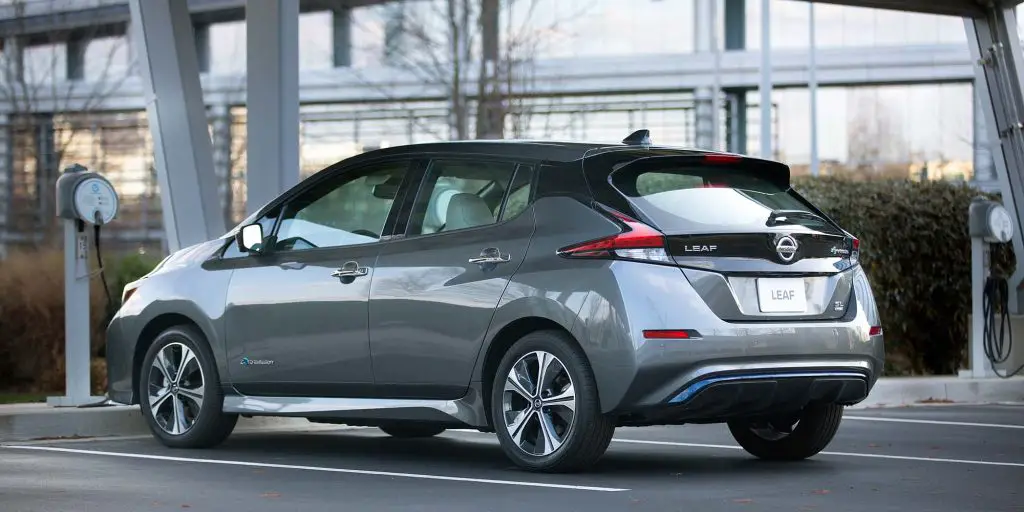
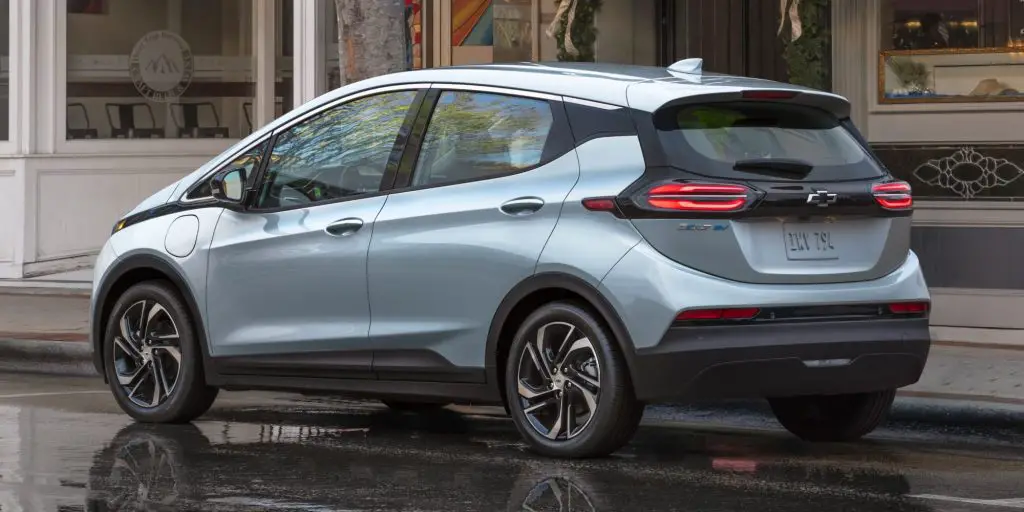
Exterior Styling
Interestingly, these two models are styled in not overly dissimilar ways. Both the Nissan Leaf and the Chevy Bolt have a hint of compressed minivan mixed with a little bit of crossover SUV about them, especially in the Leaf Plus models.
Note: For 2022, it’s worth noting that Chevrolet has released the all-new Bolt EUV, which is much closer to a regular crossover SUV in size and form. However, it starts at a higher price than the regular Bolt EV.
Both the Bolt EV and Leaf have a sense of urban chic and dynamism about them, with clean lines, sturdy builds, and a cosmopolitan sheen. The Nissan Leaf is the longer-looking of the two, with the Bolt feeling more compact in build.
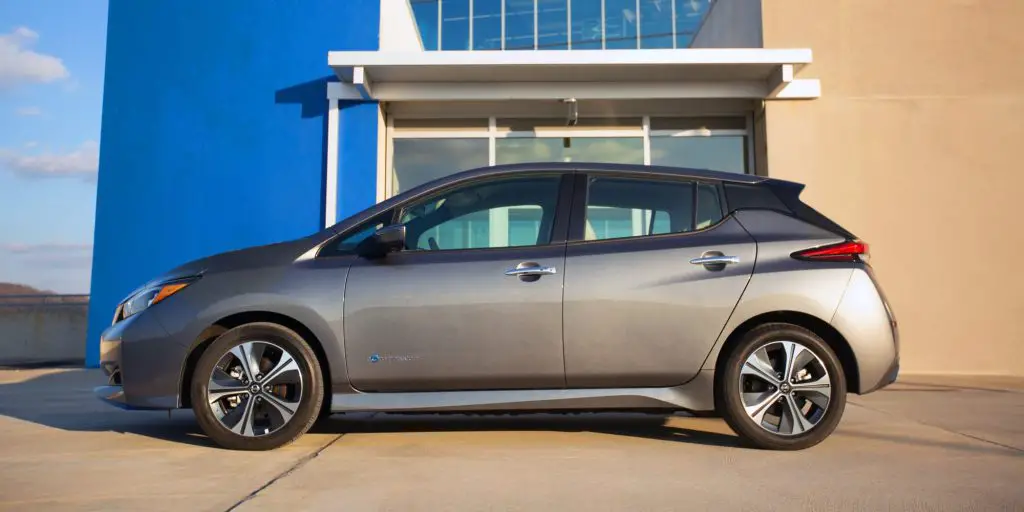
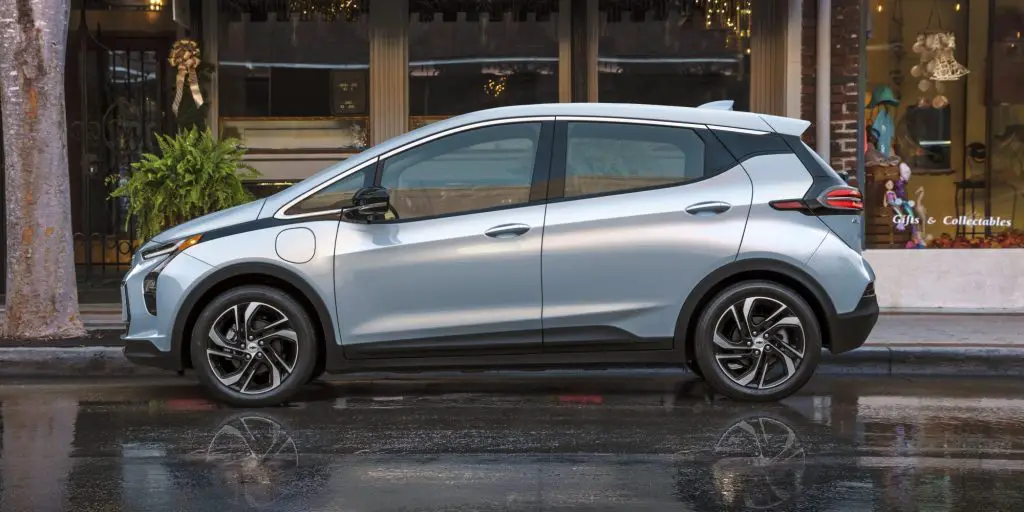
Interior
Since the Bolt only offers 2 trim levels, you get a fairly decent level of interior appointment even at the base level, more so than the Leaf. The base-level Nissan Leaf contains rather a lot of cheap plastic and cloth, but once you get to the SL model and over, things get better with light gray leathers, soft-touch materials and a generally more stylish look.
The Bolt 2LT gets stylish perforated leather appointed seats, a heated flat-bottom steering wheel, and a very comfortable 36 inches of rear-seat leg room (compared to just 33.5 inches on the Leaf). The Bolt got a good redesign in the interior for 2022, so the latest models are looking better than ever.
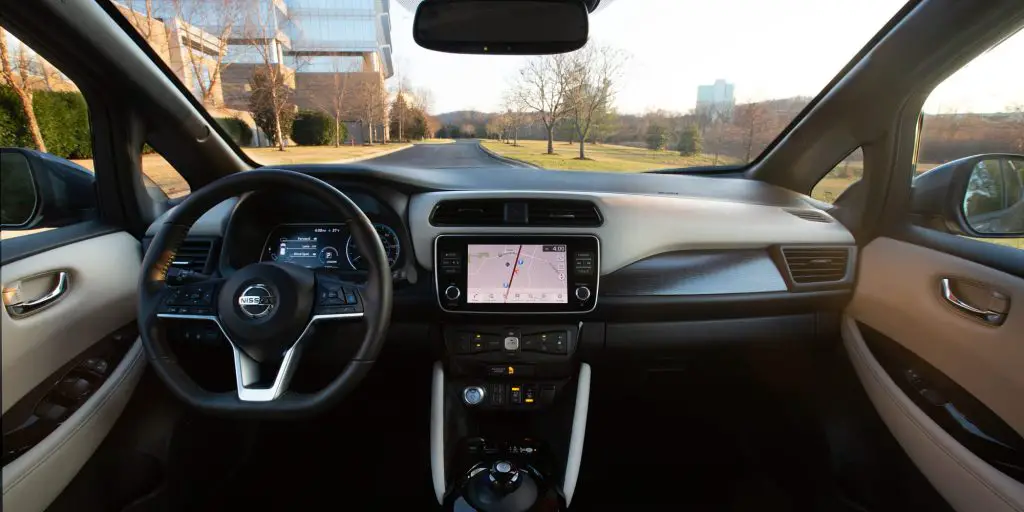
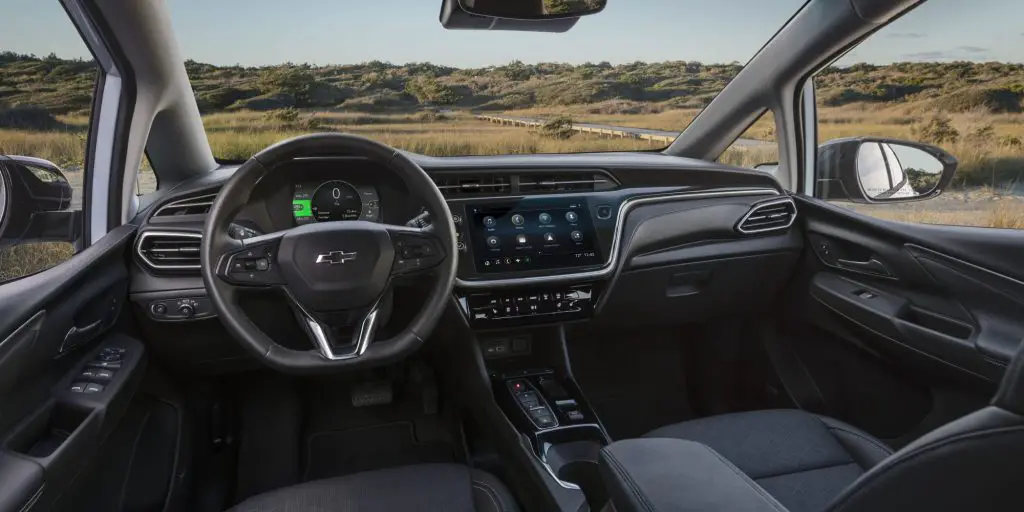
Performance
The standard Nissan Leaf powertrain is a 40-kWh battery pack paired with a 147-hp electric motor, but you can upgrade to a 62-kWh battery with 214-hp if you go higher in the trim set.
The Chevy Bolt runs on a 65-kWh battery with its electric motor delivering 200-hp. The Leaf gets 0-60 in 7.7 seconds, but the Bolt is a whole second faster at 6.7 seconds. Neither feel sluggish though thanks to the instant torque you get from an all-electric powertrain.
Both models feature the much-desired one-pedal drive feature with regenerative braking that allows rush-hour drivers a less stressful time moving through heavy traffic as they don’t have to keep jumping pedals. The Bolt’s regenerative braking also features an adjustable mode which is handy when you need the brakes to be at different strengths in different conditions. Not even Tesla models allow that.
On the road, both feel balanced, stable, and capable. The weight of the battery pack helps prevent roll and other unpleasant feelings when going round corners at speed.
Driving Range
For EVs, the primary consideration when it comes to practicality is range. It’s the Chevrolet Bolt that comes out on top with a standard 259-mile EPA estimated range regardless of trim level.
The Leaf’s 40-kWh battery has a range of 149 miles, and the 62-kWh battery up to 226 miles, both of which fall short of that offered by the Bolt.
Charging Speed
One more area to consider is charging speeds and capacities. For the Leaf, if using level 2 home charging at 240-volts, then the 40-kWh battery will charge from empty to full in 8 hours, and the 62-kWh battery in 11.5 hours. On the Bolt, level 2 home charging takes 7 hours, which is faster than the Leaf.
Both work with DC fast charging, with the Bolt being able to add 100 miles of range in 30 minutes. Nissan claims that its 40-kWh battery can get to 80 percent in 40 minutes on a 50-kW fast charge, and 45 minutes for the 62-kWh battery when using a 100-kW charge. In reality, these DC charge times are quite close, and depend more on the starting point since it is virtually never starting from zero when at a public charging station.
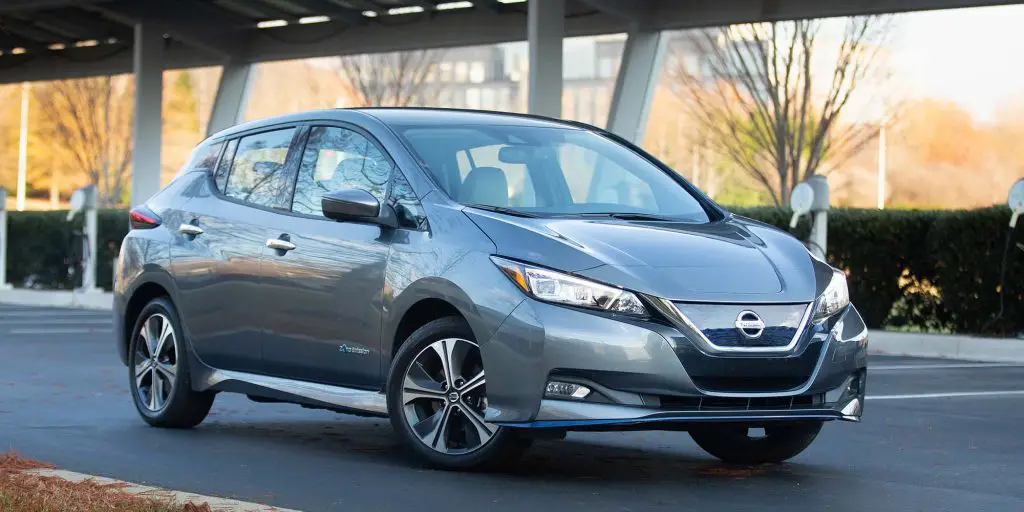
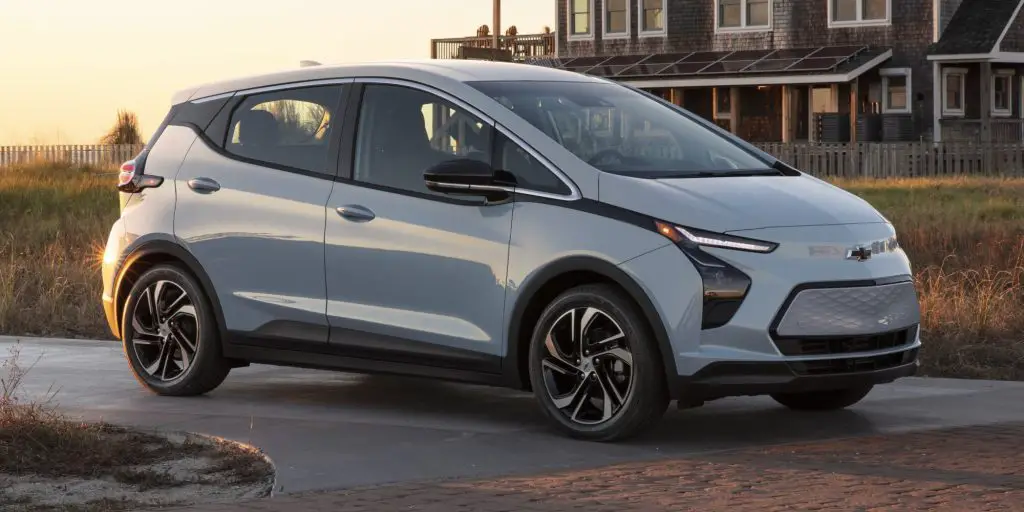
Practicality
How do they fare when it comes to cargo space? The Nissan Leaf is better with the seats up, offering 23.6 cubic feet of cargo capacity.
The Bolt only offers 16.6 cubic feet with the seats up, but up to 57 cubic feet with rear seats folded down. The Leaf only goes up to 30 cubic feet when the rear seats are folded.
Both seat up to five passengers, but the Chevy Bolt offers a slightly more spacious cabin with more space for those in the back.
Technology & Features
For infotainment systems, the Bolt gets the bigger screen at 10.2 inches, compared to an 8-inch standard setup on the Nissan Leaf. The Nissan infotainment system, NissanConnect, however, is arguably more intuitive and user-friendly, even though it’s not that much to look at.
Both electric vehicles are equipped with a 6-speaker audio system, but both can also be upgraded to a 7-speaker Bose system. The Bolt’s speaker upgrade also comes with wireless charging and an additional 2 USB ports in the rear seats, too, so it’s good value. Wireless Apple CarPlay and Android Auto are an option, too, on the Bolt. The Nissan Leaf, on the other hand, only offers standard CarPlay and Android Auto.
Higher trims of the Leaf can get Nissan’s ProPILOT Assist system to make highway driving easier with lane centering and dynamic cruise control with distance-keeping tool between your Leaf and other traffic. You can buy a similar package on the Bolt, but it comes separately. Both models also feature over-the-air updates.
Safety
For the Chevy Bolt, standard safety features include automatic emergency braking, lane keep assist, lane departure warning, forward collision alert, front pedestrian braking, and following distance indicator.
Nissan is a bit more generous, adding in rear automatic braking, rear cross-traffic alert, blind-spot warning, and high beam assist. If you have ProPILOT Assist in your Nissan Leaf as well, then you can enjoy a suite of lane-monitoring technology that helps you stay even safer on the highway.
Key Rivals
There aren’t many alternatives in this affordable EV category, save for the Mini Cooper Electric which suffers from an impractical 110-mile driving range. You really need take your budget up a notch to access the likes of the Tesla Model 3, VW ID.4, and Kia EV6.
Related: VW ID.4 vs Tesla Model Y
Verdict
City dwellers in need of an electric vehicle will find a lot to love about both of these models. However, the Nissan Leaf clearly offers a better price point, with the price potentially dipping under $20,000 if you factor in all subsidies and rebates on the base model.
The Chevrolet Bolt EV can also be reasonably priced with those incentives, but it seems it will always cost more at the basic level. The high-trim 2LT Chevy Bolt however is cheaper than the higher-level Leaf models.
Ultimately with these two, it seems to come down to range. If you want to have an EV with longer range, then there’s no beating the Bolt that has a standard range of 259 miles. That gives many years of decent long-range driving. You have to go for the larger battery option on the Leaf to get close to that.
For affordability, therefore, the Leaf wins, but for range, it’s the Bolt. In many other ways they are quite evenly matched, although the Chevy Bolt’s more recent redesign makes it feel a little more modern.
Comparison Table
| 2022 Nissan Leaf | 2022 Chevrolet Bolt EV | |
|---|---|---|
| Trim | ||
| Price | $27400 | $31500 |
| Performance | ||
| Engine | Electric | Electric |
| Horsepower | 147 hp @ 3282 rpm | 200 hp |
| Torque | 236 lb-ft | 266 lb-ft |
| Transmission | Single Speed Automatic | Single Speed Automatic |
| Drivetrain | Front-Wheel Drive | Front-Wheel Drive |
| Handling | ||
| Steering Type | Rack-Pinion | Column-Mounted Electric Pwr |
| Rear Suspension | Torsion Beam | Compound Crank (Torsion Beam) |
| Rear Wheel Size | P205/55HR16 | P215/50R17 |
| Front Suspension | Strut | MacPherson Strut |
| Front Wheel Size | P205/55HR16 | P215/50R17 |
| Turning Diameter (ft.) | 34.8 | 34.8 |
| Fuel Economy | ||
| MPG/MPGe - Hwy | 99 | 109 |
| MPG/MPGe - City | 123 | 131 |
| MPG/MPGe - Combined | 111 | 120 |
| Size and Weight | ||
| Height (in.) | 61.4 | 63.4 |
| Length (in.) | 176.4 | 163.2 |
| Weight (lbs) | 3516 | 3589 |
| Max Width (in.) | 70.5 | 69.5 |
| Wheelbase (in.) | 106.3 | 102.4 |
| Interior Dimensions | ||
| Seating Capacity | 5 | 5 |
| Front Seat Leg Room (in.) | 42.1 | 44.3 |
| Front Seat Head Room (in.) | 41.2 | 40.1 |
| Front Seat Hip Room (in.) | 51.7 | 51.3 |
| Front Seat Shoulder Room (in.) | 54.3 | 54.6 |
| Rear Seat Leg room (in.) | 33.5 | 36.0 |
| Rear Seat Head Room (in.) | 37.3 | 37.9 |
| Rear Seat Hip Room (in.) | 50.0 | 50.6 |
| Rear Seat Shoulder Room (in.) | 52.5 | 52.8 |
| Infotainment Features | ||
| HD Radio | Not Available | Not Available |
| MP3 Player | Standard | Not Available |
| WiFi Hotspot | Not Available | Standard |
| Satellite Radio | Standard | Standard |
| Bluetooth Connection | Standard | Standard |
| Entertainment System | Not Available | Not Available |
| Premium Sound System | Not Available | Not Available |
| Auxiliary Audio Input | Standard | Standard |
| Smart Device Integration | Standard | Standard |
| Hard Disk Drive Media Storage | Not Available | Not Available |
| Interior Trim | ||
| Cloth Seats | Standard | Standard |
| Vinyl Seats | Not Available | Standard |
| Leather Seats | Not Available | Standard |
| Premium Synthetic Seats | Not Available | Standard |
| Bucket Seats | Standard | Not Available |
| Sun/Moonroof | Not Available | Not Available |
| Leather Steering Wheel | Not Available | Optional |
| Woodgrain Interior Trim | Not Available | Not Available |
| Comfort Features | ||
| A/C | Standard | Standard |
| Rear A/C | Not Available | Not Available |
| Telematics | Not Available | Standard |
| Seat Memory | Not Available | Not Available |
| Seat-Massage | Not Available | Not Available |
| Keyless Entry | Standard | Standard |
| Keyless Start | Standard | Standard |
| Cruise Control | Standard | Standard |
| Multi-Zone A/C | Not Available | Not Available |
| Power Liftgate | Not Available | Standard |
| Climate Control | Standard | Standard |
| Head-Up Display | Not Available | Not Available |
| Power Mirror(s) | Standard | Standard |
| Automatic Parking | Not Available | Not Available |
| Navigation System | Not Available | Standard |
| Power Driver Seat | Not Available | Optional |
| Cooled Rear Seat(s) | Not Available | Not Available |
| Hands-Free Liftgate | Not Available | Not Available |
| Heated Rear Seat(s) | Not Available | Not Available |
| Remote Engine Start | Not Available | Standard |
| Cooled Front Seat(s) | Not Available | Not Available |
| Heated Front Seat(s) | Not Available | Optional |
| Power Passenger Seat | Not Available | Not Available |
| Remote Trunk Release | Not Available | Standard |
| Heated Steering Wheel | Not Available | Optional |
| Adaptive Cruise Control | Not Available | Not Available |
| Navigation from Telematics | Not Available | Not Available |
| Universal Garage Door Opener | Not Available | Not Available |
| Steering Wheel Audio Controls | Standard | Standard |
| Safety Features | ||
| ABS | Standard | Standard |
| Brake Assist | Standard | Not Available |
| Night Vision | Not Available | Not Available |
| Rear Parking Aid | Standard | Optional |
| Traction Control | Standard | Standard |
| Stability Control | Standard | Standard |
| Blind Spot Monitor | Standard | Optional |
| Cross-Traffic Alert | Not Available | Optional |
| Lane Keeping Assist | Standard | Standard |
| Tire Pressure Monitor | Standard | Standard |
| Lane Departure Warning | Standard | Standard |
| Airbags | ||
| Knee Air Bag | Standard | Standard |
| Driver Air Bag | Standard | Standard |
| Seatbelt Air Bag | Not Available | Not Available |
| Passenger Air Bag | Standard | Standard |
| Rear Head Air Bag | Standard | Not Available |
| Rear Side Air Bag | Standard | Not Available |
| Front Head Air Bag | Standard | Standard |
| Front Side Air Bag | Standard | Standard |
| Warranty | ||
| Basic | 3 Years / 36,000 Miles | 3 Years / 36,000 Miles |
| Corrosion | 5 Years / Unlimited Miles | 3 Years / 36,000 Miles |
| Drivetrain | 5 Years / 60,000 Miles | Qualified Fleet Purchases: 5 Years/100,000 Miles |
| Maintenance | - | 1 Year/1 Visit |
| Roadside Assistance | 3 Years / Unlimited Miles | Qualified Fleet Purchases: 5 Years/100,000 Miles |
